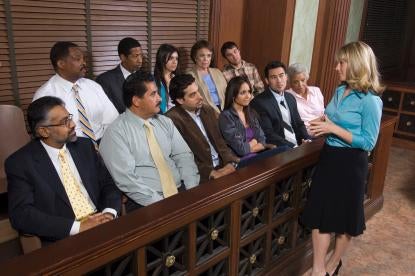In a recent jury research exercise for a product liability case, both the plaintiff and the defendant presented testimony from their respective medical expert, each offering her professional opinion as to the primary mechanism of injury for the plaintiff’s wounds. Unsurprisingly, the plaintiff expert’s interpretation of the medical records supported the plaintiff’s theory of the case, and the defense expert’s supported the defendant’s. But when the mock jurors were asked after the testimony which mechanism of injury seemed most probable, an interesting pattern emerged: nearly all jurors who were already leaning toward the plaintiff argued that the medical records clearly supported the plaintiff expert’s theory, while those who had been supporting the defense were adamant that the exact same evidence clearly supported the defense expert’s theory.
Why did these jurors’ beliefs about the case dictate their assessment of the experts’ testimony rather than the other way around? As counterintuitive as it may seem, the jurors were exhibiting an extremely common pattern of cognition: confirmation bias.
What Is Confirmation Bias?
First described in the 1960s by English psychologist Peter Wason, confirmation bias—also sometimes referred to as the “myside bias”—is the tendency to search for, interpret, and preferentially recall information in ways consistent with one’s pre-existing beliefs or expectations. Confirmation bias is a universal human tendency, and it can influence people’s judgment and decision-making without their conscious awareness. That is, everyone does it, and they often do not even know they are doing it. Once you know what to look for, however, you will be able to spot its influence in almost any situation.
How Confirmation Bias Affects Jurors
Both anecdotal evidence and empirical research show us that many jurors first determine which side they favor and then interpret the evidence in a way that aligns with their preference. While this does not mean that jurors “decide after openings,” it does mean that confirmation bias, left unchecked, can wreak havoc in the courtroom.
Whether they know it or not, every juror carries a lifetime of experiences and corresponding expectations into the jury box, all of which affect how they filter the information they hear and how they assign weight to the various evidence. For example, jurors who stereotype a defendant (e.g., “All corporations put profits over people”) often let those strong beliefs color their opinions about the case (e.g., “So, the plaintiff’s argument that the corporation prioritized profits over consumer safety makes sense”). The jurors are primed to seek out anything that plays into their notions about the defendant while simultaneously being more inclined to overlook or dismiss competing information.
Strategies for Combatting Confirmation Bias
Confirmation bias can be exceedingly tricky to combat due to the way it pervades human cognition. However, there are several strategies you can use to mitigate the effects of confirmation bias and increase your chances of convincing jurors.
ELICIT CONFIRMATION BIAS DURING VOIR DIRE
Crafting an effective voir dire is a critical first step, as it is always best to prevent potentially biased jurors from being seated if possible. First, attorneys should question jurors regarding their tendency to favor one party over the other without even having heard the evidence and arguments. Jurors who are alerted to the possibility of their confirmation bias may be willing to admit that, due to their preference for one party over the other, they may be unable to be sufficiently impartial.
One strategy for eliciting this type of information is by framing it within the context of sympathy and general anti-corporate attitudes. Identify the proper language in your venue to elicit cause, then build a line of questioning that meets the standard for such challenges. During questioning, remind jurors that having biases or preferences is completely normal and that it does not make them an unfit juror in general, but rather that this particular case just might not be the right case for them.
Note: We recommended that jurors not be asked for a precommitment to be fair before this line of questioning. Jurors, and people in general, often like to see themselves in a positive light—a precommitment to be fair can hinder their willingness to admit bias against a defendant later on.
INCREASE JURORS’ MOTIVATION TO THINK CRITICALLY
Research shows that people are more vulnerable to confirmation bias when they allow themselves to be “cognitively lazy.” This makes sense when you consider the fact that confirmation bias, at its most fundamental level, is a mental shortcut that people rely on to lighten their overall cognitive load. Engaging in critical thinking is mentally taxing, and people are more likely to exert the necessary effort when their motivation levels are high.
To increase jurors’ mental motivation, present the case in a way that highlights its importance and makes it seem personally relevant to the jury. Relate it to jurors’ own experiences and attitudes, using language and terminology that aligns with how they are already thinking about it. Holding an inductive research exercise, such as a focus group, can be a great way to gain valuable insight into how jurors are likely to think and talk about your case.
KEEP IT SIMPLE
Motivation alone is insufficient when it comes to getting people to think critically. As cognitive processing research demonstrates, people also needto be capable of evaluating the merits of the argument. The issue of capability frequently surfaces in complex trials that require jurors to hear highly technical testimony, understand nuanced legal arguments, and keep track of multiple interrelated parties.
Remember that jurors are rarely lawyers or experts in a case-relevant field. There may be fundamental features of your case that they have never heard of. To the extent possible, present your facts in a simple, straightforward manner and avoid overreliance on technical jargon. Not only can jury research identify the means to motivate jurors, but it can also be a powerful resource for determining how to frame your case in accessible ways. Additionally, witness preparation and trial graphics are valuable tools in helping attorneys and witnesses convey complex information simply.
ESTABLISH A STRONG STORY, EARLY ON
Since jurors, as people, are going to engage in confirmation bias, try to make it work in your favor. By presenting jurors with a coherent, themes-based narrative from the very beginning, you provide a strong “mental scaffold” upon which you—and they—can build your case. Think of it as getting in on the ground floor before opposing counsel’s competing story can fully sink in.
For defendants, that will mean putting forth an affirmative case, not one that simply responds to plaintiffs’ claims and allows them to control the narrative moving forward. Once you establish the basic framework of your case, show jurors exactly where and how to plug in each new piece of evidence, emphasizing how it fits into the bigger picture. Placing evidence under various thematic umbrellas has the added benefit of making the information easier for jurors to recall in deliberations.
MINIMIZE AMBIGUITY
Because confirmation bias involves the interpretation of information, it flourishes most easily in the “gray areas” of a case. Psychological research has shown that jurors are most strongly influenced by their pre-existing biases when tasked with interpreting ambiguous evidence, as the ambiguity creates more room for these biases to distort jurors’ judgment.[v] If your case involves a piece of evidence that could be interpreted as either supporting or refuting your narrative, take extra care to lay out exactly why jurors should view it as favorable to your side. Minimizing points of ambiguity will reduce opportunities for jurors’ biases to enter the equation.
Of course, identifying those ambiguities is not always so easy. During focus groups and mock trials, we find that attorneys are often astounded at jurors’ ability to interpret seemingly rock-solid evidence in an unfavorable way. In this regard, counsel may find additional benefit from pretrial research, as it can identify points of confusion and ambiguity and, subsequently, test ways to clarify them.
In Conclusion
Confirmation bias may be a universal pitfall of human cognition, but it is possible to reduce its effects on your jurors’ decision-making. By establishing a strong, compelling case narrative that jurors find approachable and personally relevant, then clearly outlining how each new piece of information fits into the bigger picture, you will effectively prime your jurors to evaluate the evidence critically—rather than letting their preconceptions light the way.
References
[i] Curley, L. J., Munro, J., & Dror, I. E. (2022). Cognitive and human factors in legal layperson decision making: Sources of bias in juror decision making. Medicine, science, and the law, 62(3), 206–215. https://doi.org/10.1177/00258024221080655
[ii] Ibid.
[iii] Kukucka, J., Hiley, A. and Kassin, S.M. (2020). Forensic Confirmation Bias: Do Jurors Discount Examiners Who Were Exposed to Task-Irrelevant Information?. J Forensic Sci, 65: 1978-1990. https://doi.org/10.1111/1556-4029.14546
[iv] Nickerson, R. S. (1998). Confirmation Bias: A Ubiquitous Phenomenon in Many Guises. Review of General Psychology, 2(2), 175–220. https://doi.org/10.1037/1089-2680.2.2.175
[v] Ibid.
With contributions from the late Katrina Cook, PhD





 i
i


